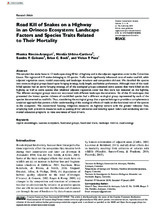| dc.creator | Rincon-Aranguri, Monica | |
| dc.creator | Urbina-Cardona, Nicolás | |
| dc.creator | Galeano, Sandra P. | |
| dc.creator | Bock, Brian C | |
| dc.creator | Paez, Vivian P | |
| dc.date.accessioned | 2019-05-13T15:45:17Z | |
| dc.date.available | 2019-05-13T15:45:17Z | |
| dc.date.issued | 2019-03-06 | |
| dc.identifier.issn | 1940-0829 | spa |
| dc.identifier.uri | https://journals.sagepub.com/doi/10.1177/1940082919830832 | spa |
| dc.identifier.uri | http://hdl.handle.net/20.500.11761/35318 | |
| dc.description | We sampled the snake fauna in 13 landscapes along 80 km of highway and in the adjacent vegetation cover in the Colombian
Llanos. We registered 119 snakes belonging to 33 species. Traffic levels significantly influenced rates of snake road kill, while
adjacent vegetation cover, rainfall seasonality, and landscape structure and composition did not. We classified the species
into seven ecological groups based upon foraging strategy, body length, and habitat preferences. Although most of the roadkilled species had an active foraging strategy, all of the ecological groups contained some species that were killed on the
highway, as well as some species that inhabited adjacent vegetation cover but that were not detected on the highway.
The different ecological groups were not associated with different landscape characteristics. Six of the 13 landscapes that
presented the lowest species richness of road-killed species had a different ecological group represented by each of the
species documented as road kills. Thus, considering the ecological group that a species belongs to provides a complementary
analytical approach that permits a fuller understanding of the ecological effects of roads on the functional role of the species
in the ecosystem. We recommend focusing mitigation measures on highway sectors with the greater vehicular flow,
employing both preventive measures such as posting driver advisories and installing speed radars and conducting environmental education programs to raise awareness of local drivers | spa |
| dc.description.abstract | Muestreamos la fauna de serpientes en 13 paisajes a lo largo de 80 km de carretera y en la cubierta vegetal adyacente en el colombiano. Llanos. Registramos 119 serpientes pertenecientes a 33 especies. Los niveles de tráfico influyeron significativamente en las tasas de muerte de serpientes en carretera, mientras que La cobertura vegetal adyacente, la estacionalidad de la lluvia y la estructura y composición del paisaje no lo hicieron. Clasificamos la especie.en siete grupos ecológicos basados en la estrategia de alimentación. | spa |
| dc.format | application/pdf | spa |
| dc.format.extent | 18 | spa |
| dc.language.iso | spa | spa |
| dc.relation.ispartofseries | Tropical Conservation Science Volume 12: 1–18 | spa |
| dc.rights | Attribution-NonCommercial-NoDerivatives 4.0 International | * |
| dc.rights.uri | http://creativecommons.org/licenses/by-nc-nd/4.0/ | * |
| dc.source | reponame: Repositorio Institucional de Documentación Científica Humboldt | spa |
| dc.source | instname: Instituto de Investigación de Recursos Biológicos Alexander von Humboldt | spa |
| dc.subject | Ensamblajes de reptiles | spa |
| dc.subject | Ecosistemas de sabana | spa |
| dc.subject | Grupos funcionales | spa |
| dc.subject | Rasgos funcionales | spa |
| dc.subject | Métricas del paisaje | spa |
| dc.subject | Ecología vial | spa |
| dc.title | Road Kill of Snakes on a Highway in an Orinoco Ecosystem: Landscape Factors and Species Traits Related to Their Mortality | spa |
| dc.type | info:eu-repo/semantics/article | spa |
| dc.type.spa | Artículo | spa |
| dc.identifier.doi | http://dx.doi.org/10.1177/1940082919830832 | spa |
| dc.publisher.edition | Regular | spa |
| dc.subject.subjectenglish | Savanna ecosystem | spa |
| dc.subject.subjectenglish | Reptile assemblages | spa |
| dc.subject.subjectenglish | Functional groups | spa |
| dc.subject.subjectenglish | Functional traits | spa |
| dc.subject.subjectenglish | Landscape metrics | spa |
| dc.subject.subjectenglish | Road ecology | spa |
| dc.publisher.journal | Tropical Conservation Science | spa |




